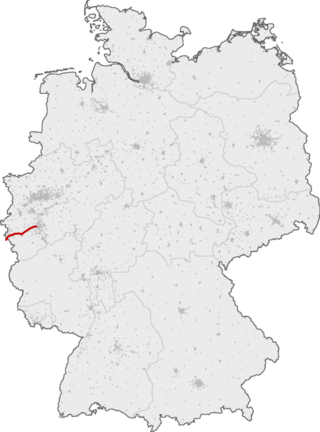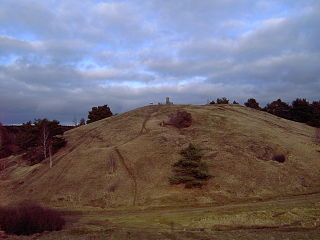
North Rhine-Westphalia or North-Rhine/Westphalia, commonly shortened to NRW, is a state (Land) in Western Germany. With more than 18 million inhabitants, it is the most populous state in Germany. Apart from the city-states, it is also the most densely populated state in Germany. Covering an area of 34,084 km2 (13,160 sq mi), it is the fourth-largest German state by size.

Eschweiler is a municipality in the district of Aachen in North Rhine-Westphalia in Germany on the river Inde, near the German-Belgian-Dutch border, and about 15 kilometres (9 mi) east of Aachen and 50 kilometres (31 mi) west of Cologne.

The Cologne–Aachen high-speed line is the German part of the Trans-European transport networks project high-speed line Paris–Brussels–Cologne. It is not a newly built railway line, but a project to upgrade the existing railway line which was opened in 1841 by the Rhenish Railway Company. When it was continued into Belgium in 1843, it became the world's first international railway line.

Stolberg is a town and a former municipality in the district of Mansfeld-Südharz, in the German State of Saxony-Anhalt, Germany. It is situated in the southern part of the Harz mountains, about 27 kilometres (17 mi) west of Sangerhausen, and 13 km (8.1 mi) northeast of Nordhausen. Since 1 September 2010, it has been part of the municipality of Südharz.

The Diocese of Aachen is a Latin diocese of the Catholic Church located in Germany and one of the six dioceses in the ecclesiastical province of Cologne. The incumbent bishop is Helmut Dieser, who was appointed by Pope Francis on 23 September 2016. The bishop's seat is Aachen.

The Rhenish Republic was proclaimed at Aachen (Aix-la-Chapelle) in October 1923 during the occupation of the Ruhr by troops from France and Belgium and subjected itself to French protectorate. It comprised three territories, named North, South and Ruhr. Their regional capitals were, respectively, Aachen, Koblenz and Essen.

Prym is an internationally active group of companies. It consists of four independent divisions that operate under the umbrella of a holding company: Prym Consumer, Prym Fashion, Prym Intimates and Inovan. The roots of the company go back to the 16th century. It is one of the oldest operating companies in the World. In 1642, the company moved from Aachen, Germany, to Stolberg (Rhineland), Germany. The headquarters have been located there ever since.

The nature reserve of Schlangenberg which means snake-mountain is located in the west of Germany close to the Dutch and Belgian border. The reserve is near the village Breinigerberg, 15 kilometres from Aachen or 7 kilometres distant from the city of Stolberg (Rhineland). Schlangenberg itself is a small hill peaking 276 m above sea level.

The Adler-Apotheke was a former brass producing factory in the German city of Stolberg. The building was founded in 1575 by Leonard Schleicher. In the 18th century it became the first pharmacy in the district of Aachen. Currently the building is protected as a cultural heritage.

Robert Oskar Julius von Görschen was one of the Aachen region’s most successful business lawyers, and an initiator of many social and cultural institutions.

Büsbach is the largest of 17 districts and villages belonging to the German town of Stolberg (Rhineland).

Eschweiler Hauptbahnhof is the largest station in the city of Eschweiler in the German state of North Rhine-Westphalia. It is on a slight curve on the Cologne–Aachen high-speed line. Regional services of the Regional-Express lines RE 1 (NRW-Express) and RE 9 (Rhein-Sieg-Express) stop at the station every half hour in both directions.

Stolberg (Rheinland) Hauptbahnhof is a railway station on the line between Cologne and Aachen. It is the largest station for passengers and freight in the town of Stolberg (Rhineland) in the urban region of Aachen in the German state of North Rhine-Westphalia. It houses the Vennbahn Museum and is situated at a junction.

The Mönchengladbach–Stolberg railway was opened by the Bergisch-Märkische Railway Company and built in sections between 1870 and 1875.
Eilendorf is a borough of Aachen, Germany, that has around 15000 inhabitants. The communities of Eilendorf and Nirm share a border with the other Aachen boroughs of Brand, Aachen-Mitte, and Haaren, as well as Atsch in Stolberg.

Kornelimünster is a town in the rural Münsterländchen area of Kornelimünster/Walheim, a district of Aachen, Germany.

Stolberg Zinc joint-stock company for mining and smelter operations in Aachen, or Stolberg Zinc Mines GmbH, is a metal mining concern in the Aachen region and specifically in the area of Eschweiler-Stolberg, with headquarters in Stolberg.
Rothe Erde is a district of Aachen, Germany with large-scale development in heavy industry. It is sub-district 34 of the Aachen-Mitte Stadtbezirk. It lies between the districts of Forst and Eilendorf.

The Blausteinsee Leisure and Recreation Area is an artificial lake north of the Eschweiler municipality in the Aachen district of North Rhine-Westphalia, Germany. Its area is around 100 hectares and depth is 46m. It was created during the regeneration of the Zukunft opencast coal mine in the Rhineland coalfield, made by flooding the pit left by the mine with water. Today, the lake is a holiday area for the surrounding towns. The surface of the lake is 129 metres above sea level and its volume is around 25 million cubic metres. The filling of the lake began in 1994.
The textile industry in Aachen has a history that dates back to the Middle Ages. The Imperial city of Aachen was the main woolen center of the Rhineland. Certain kind of woolens made there were illustrated as "Aachen fine cloth". These high-quality fine woolens have a plain weave structure using carded merino wool yarns, and a raised surface. The production of high-quality, fine cloth required fine foreign wool and skilled craftsmen and was reserved for town craftsmen. It involved regulated steps including sorting, combing, washing, spinning, fulling, dyeing, shearing, and pressing the wool. The finished products were inspected and authorized with a town trademark before being sold and exported. Fine cloth was a major export in the Middle Ages.























